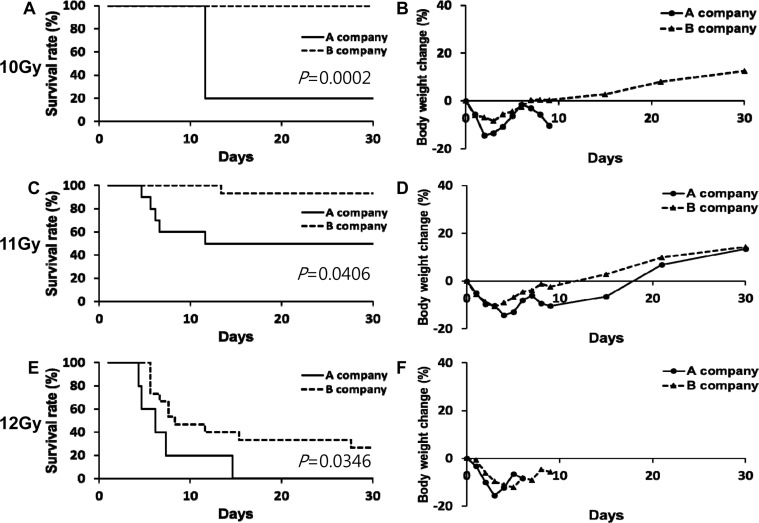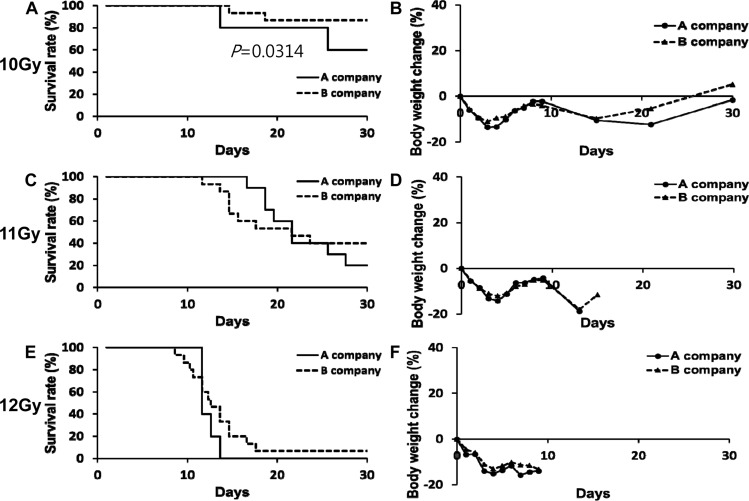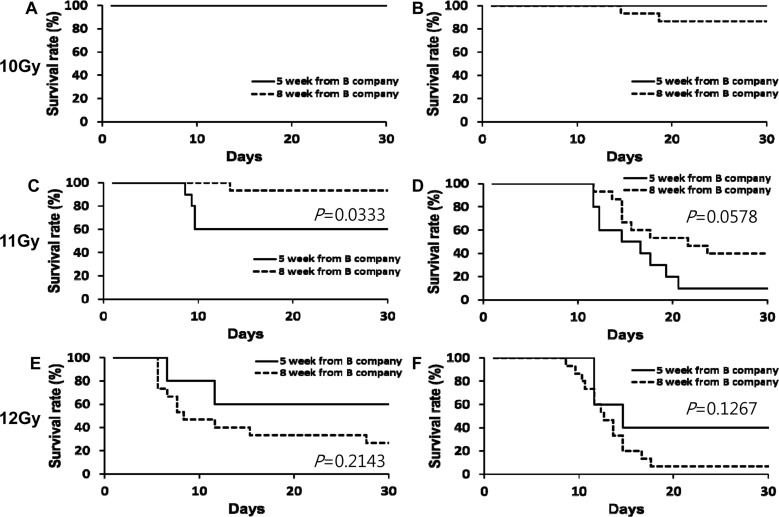Lab Anim Res.
2016 Jun;32(2):116-121. 10.5625/lar.2016.32.2.116.
Establishment of a mouse model of 70% lethal dose by total-body irradiation
- Affiliations
-
- 1Department of Laboratory Animal Medicine, College of Veterinary Medicine, Konkuk University, Seoul, Korea. yangkyuc@konkuk.ac.kr
- 2Laboratory Animal Center, Daegu-Gyeongbuk Medical Innovation Foundation, Daegu, Korea.
- 3Molecular Imaging Research Center, Korea Institute of Radiological and Medical Sciences, Seoul, Korea.
- KMID: 2309085
- DOI: http://doi.org/10.5625/lar.2016.32.2.116
Abstract
- Whereas increasing concerns about radiation exposure to nuclear disasters or side effects of anticancer radiotherapy, relatively little research for radiation damages or remedy has been done. The purpose of this study was to establish level of LD70/30 (a lethal dose for 70% of mice within 30 days) by total-body γ irradiation (TBI) in a mouse model. For this purpose, at first, 8-week-old male ICR and C57BL/6N mice from A and B companies were received high dose (10, 11, 12 Gy) TBI. After irradiation, the body weight and survival rate were monitored for 30 days consecutively. In next experiment, 5-week-old male ICR and C57BL/6N mice from B company were received same dose irradiation. Results showed that survival rate and body weight change rate in inbred C57BL/6N mice were similar between A and B company. In ICR mice, however, survival rate and body weight change rate were completely different among the companies. Significant difference of survival rate both ICR and C57BL6N mice was not observed in between 5-week-old and 8-week-old groups receiving 10 or 12 Gy TBI. Our results indicate that the strain and age of mice, and even purchasing company (especially outbred), should be matched over experimental groups in TBI experiment. Based on our results, 8-week-old male ICR mice from B company subjected to 12 Gy of TBI showed LD70/30 and suitable as a mouse model for further development of new drug using the ideal total-body irradiation model.
Keyword
MeSH Terms
Figure
Reference
-
1. Zhang C, Ni J, Li BL, Gao F, Liu H, Liu W, Huang YJ, Cai JM. CpG-Oligodeoxynucleotide Treatment Protects against Ionizing Radiation-Induced Intestine Injury. PLoS One. 2013; 8(6):e66586. PMID: 23805241.
Article2. Herodin F, Drouet M. Cytokine-based treatment of accidentally irradiated victims and new approaches. Exp Hematol. 2005; 33(10):1071–1080. PMID: 16219528.3. Koenig KL, Goans RE, Hatchett RJ, Mettler FA Jr, Schumacher TA, Noji EK, Jarrett DG. Medical treatment of radiological casualties: current concepts. Ann Emerg Med. 2005; 45(6):643–652. PMID: 15940101.
Article4. Plett PA, Sampson CH, Chua HL, Joshi M, Booth C, Gough A, Johnson CS, Katz BP, Farese AM, Parker J, MacVittie TJ, Orschell CM. Establishing a murine model of the hematopoietic syndrome of the acute radiation syndrome. Health Phys. 2012; 103(4):343–355. PMID: 22929467.
Article5. Dorr HD, Meineke V. Appropriate radiation accident medical management: necessity of extensive preparatory planning. Radiat Environ Biophys. 2006; 45(4):237–244. PMID: 17047978.
Article6. Bentzen SM. Preventing or reducing late side effects of radiation therapy: radiobiology meets molecular pathology. Nat Rev Cancer. 2006; 6(9):702–713. PMID: 16929324.
Article7. Hwang JH, Chang HJ, Shim YH, Park WH, Park W, Huh SJ, Yang JH. Effects of supervised exercise therapy in patients receiving radiotherapy for breast cancer. Yonsei Med J. 2008; 49(3):443–450. PMID: 18581595.
Article8. Senkus-Konefka E, Jassem J. Complications of breast-cancer radiotherapy. Clin Oncol (R Coll Radiol). 2006; 18(3):229–235. PMID: 16605054.
Article9. Jereczek-Fossa BA, Marsiglia HR, Orecchia R. Radiotherapy-related fatigue. Crit Rev Oncol Hematol. 2002; 41(3):317–325. PMID: 11880207.
Article10. Williams D. Radiation carcinogenesis: lessons from Chernobyl. Oncogene. 2008; 27:S9–S18. PMID: 19956182.
Article11. Morgan WF, Day JP, Kaplan MI, McGhee EM, Limoli CL. Genomic instability induced by ionizing radiation. Radiat Res. 1996; 146(3):247–258. PMID: 8752302.
Article12. Burdelya LG, Krivokrysenko VI, Tallant TC, Strom E, Gleiberman AS, Gupta D, Kurnasov OV, Fort FL, Osterman AL, Didonato JA, Feinstein E, Gudkov AV. An agonist of toll-like receptor 5 has radioprotective activity in mouse and primate models. Science. 2008; 320(5873):226–230. PMID: 18403709.
Article13. Krivokrysenko VI, Shakhov AN, Singh VK, Bone F, Kononov Y, Shyshynova I, Cheney A, Maitra RK, Purmal A, Whitnall MH, Gudkov AV, Feinstein E. Identification of granulocyte colony-stimulating factor and interleukin-6 as candidate biomarkers of CBLB502 efficacy as a medical radiation countermeasure. J Pharmacol Exp Ther. 2012; 343(2):497–508. PMID: 22837010.
Article14. Wang ZD, Qiao YL, Tian XF, Zhang XQ, Zhou SX, Liu HX, Chen Y. Toll-like receptor 5 agonism protects mice from radiation pneumonitis and pulmonary fibrosis. Asian Pac J Cancer Prev. 2012; 13(9):4763–4767. PMID: 23167416.
Article15. Burdelya LG, Gleiberman AS, Toshkov I, Aygun-Sunar S, Bapardekar M, Manderscheid-Kern P, Bellnier D, Krivokrysenko VI, Feinstein E, Gudkov AV. Toll-like receptor 5 agonist protects mice from dermatitis and oral mucositis caused by local radiation: implications for head-and-neck cancer radiotherapy. Int J Radiat Oncol Biol Phys. 2012; 83(1):228–234. PMID: 22000579.
Article16. Rice AS, Cimino-Brown D, Eisenach JC, Kontinen VK, Lacroix-Fralish ML, Machin I. Preclinical Pain Consortium. Mogil JS, Stohr T. Animal models and the prediction of efficacy in clinical trials of analgesic drugs: a critical appraisal and call for uniform reporting standards. Pain. 2008; 139(2):243–247. PMID: 18814968.
Article17. Talmadge JE, Singh RK, Fidler IJ, Raz A. Murine models to evaluate novel and conventional therapeutic strategies for cancer. Am J Pathol. 2007; 170(3):793–804. PMID: 17322365.
Article18. Singh VK, Newman VL, Berg AN, MacVittie TJ. Animal models for acute radiation syndrome drug discovery. Expert Opin Drug Discov. 2015; 10(5):497–517. PMID: 25819367.
Article19. Krigsfeld GS, Savage AR, Billings PC, Lin L, Kennedy AR. Evidence for radiation-induced disseminated intravascular coagulation as a major cause of radiation-induced death in ferrets. Int J Radiat Oncol Biol Phys. 2014; 88(4):940–946. PMID: 24495588.
Article20. Shim S, Jang WS, Lee SJ, Jin S, Kim J, Lee SS, Bang HY, Jeon BS, Park S. Development of a new minipig model to study radiation-induced gastrointestinal syndrome and its application in clinical research. Radiat Res. 2014; 181(4):387–395. PMID: 24786169.
Article21. Sanzari JK, Wan XS, Krigsfeld GS, King GL, Miller A, Mick R, Gridley DS, Wroe AJ, Rightnar S, Dolney D, Kennedy AR. Effects of solar particle event proton radiation on parameters related to ferret emesis. Radiat Res. 2013; 180(2):166–176. PMID: 23883319.
Article
- Full Text Links
- Actions
-
Cited
- CITED
-
- Close
- Share
- Similar articles
-
- The Effect of Combination of Radiation with 5-luorouracil on Mouse Jejunal Crypt Cells
- Radiation Effect on Mouse Jejunal Crypt Cells by Single and Split Irradiation
- A Study on the Dose Distribution for Total Body Irradiation using Co-60 Teletherapy Unit
- Total Body Irradiation Technique: Basic Data Measurements and In Vivo Dosimetry
- Acute Response to Co-60 Total Body Irradiation (TBI) With 600 cgy at 3 Different Does Rates in the Mice




